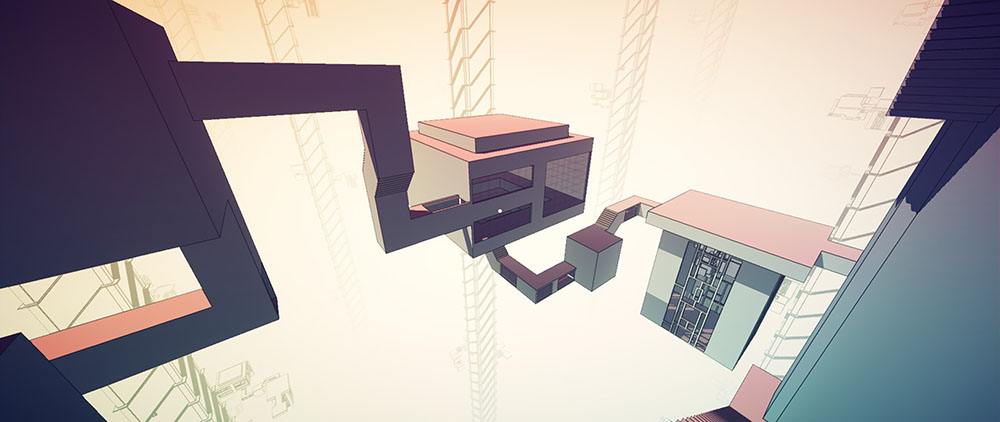Let's have a look at Manifold Garden, a mindbending indie puzzle game from 2019. Two years and a million years
ago.
Manifold Garden was developed for iOS and the PC, then
subsequently ported to all the other popular platforms - PlayStation, XBox,
Nintendo Switch - but not stupid sucky Android. I remember seeing screenshots of it at the time but I ignored it, because it was 2019 and life was sweet.
Like
most people in those pre-pandemic days I spent the whole year eating squirty
cream and having naked baths with attractive women while flying first-class
around the world. That was life before the pandemic.
But all good things come to an end, and I have time to kill, and Manifold Garden is out on
budget, so let's see what it's like. As of 2021 the
game is still widely available for all of the aforementioned platforms, plus
the PlayStation 5. I played it on my PC.
Is it any good? Yes, although I felt that if it had gone on any longer it
would have worn out its welcome.
What's it like? It's essentially an abstract puzzle game. Unlike
Far: Lone Sails or
The Talos Principle or The Witness it doesn't have a theme and it doesn't attempt to tell a story. There
are no characters, no storyline, no dialogue. I was surprised to see mention
of a localisation team in the credits, because apart from the interface text
there are no words or story nodes or anything like that. Instead it has masses of architecture. One hundred per cent Albert Speer, zero per cent Beatrix Potter.
You're a blank empty camera that moves around a 3D world. You have the power
to pick up cubes and press buttons, but not much else. You can't jump, for
example. You can fall arbitrarily long distances, and you have a certain
amount of control in the air, but you can't fly. You have no special powers,
no inventory, nothing like that.
Tell a lie. You have one special power. You can change the direction of
gravity. By moving up to a surface and clicking on it you can make that
surface the floor, at which point the entire world spins around and suddenly
the floor you were standing on a moment ago is a wall. You can do this while falling, and with a bit of practice you can scurry around the world like a spider.
Some objects are affected by gravity, such as the white ball in the screenshot
above. In that puzzle I had to guide the ball through a series of tunnels by
altering gravity whenever the ball reached a junction.
Other puzzles involve manipulating boxes that are only affected by gravity in
one direction. In the screenshots above the red boxes are being pulled down to the
floor, but the white boxes are fixed in place until I twist the room upside
down. Thus I can use the white boxes as stepping-stones or anchors.
There are other mechanics. Some levels have streams of water that can be used
as makeshift bridges if the gravity is pointing in the right direction. The
streams can also be diverted by boxes in order to power a water wheel, or grow
a tree that produces new boxes. The game generally does a good job of
explaining all of this non-verbally, although I only stumbled on the water
diversion by accident. Perhaps in a future revision the developers could start
by having a box already diverting water, instead of relying on the
player to find it out by trial and error.
Later on there are huge Tetris bricks that have to be manipulated into place
by turning the world around. Thankfully they can't crush you. In fact you
can't die. The levels wrap around, and
sometimes the most effective way to get from one place to another is to drop
off the edge of one building and sail down to land on another. Although it's alarming to watch, falling great heights doesn't hurt.
The game takes place in a series of colour-themed levels, each of which
involves solving puzzles so that you can activate a laser, a la
The Witness. At that point the colours become inverted and you have to
slot a scary cube into a wobbly tree - without your gravity-bending powers -
and then a new world appears. There about about four or five worlds, and
according to Steam I finished the game in 7.7 hours. But that includes a lot
of time taking screenshots and using the photo mode. The photo mode reminded
me a bit of the old arcade game I Robot.
Garden also reminded me a couple of other games from the 1980s. At
the top-left of the montage above there's
Knot in 3D, a clone of
Snake that came out in 1983. It used
Dungeon Master-style 90-degree flip-screen 3D rather than proper polygons, but it was still
an impressive technical feat for the period. It was written by a chap called
Malcolm Evans, an early pioneer of 3D games. He also wrote
3D Monster Maze for the ZX81.
Also pictured is (clockwise) Mercenary, which has some of
Garden's sense of scale, and I Of the Mask, which didn't remind
me very much of Manifold Garden but I can't have just three
pictures, can I? I can't have three pictures. The montage wouldn't be square
if I had three pictures. I could have put The Sentinel but its
geometry was relatively normal.
Manifold Garden's big thing is the visuals, which are striking. Each
new section is carefully designed in such a way that you burst through a
portal into a giant wide open space. It would be horrifying in VR. It's not
quite as big as it seems in screenshots, because the levels wrap around, and it's often surprisingly conservative, in the sense that the really mindbending gravity-reversal
puzzles take place indoors, with the outdoors sections usually having
a definite "up" and "down".
Gameplay-wise I felt as if the game was pulling its punches. Quite often the
puzzles looked nasty at first, but after moving blocks around randomly I
stumbled on the solution by accident. One section involves diverting water
into some portals that defy the laws of space, but although the resulting
pathway looks bizarre - you even get an achivement for completing
it - the actual solution is a simple W-shaped back-and-forth path.



I mention this because the interplay of Tetris bricks, interdimensional
portals, giant spaces, gravity-defying waterfalls and intricately-designed
structures could have made for some incredibly aggravating, hatefully
overcomplicated sequence-perfect Kaizo Mario-style puzzles, but on the
whole the gameplay is surprisingly mellow. There are no timed puzzles, for example. The final segment was irritating
but only because it involved a lot of climbing. Beyond that I breezed through
it. Perhaps it's because I've grown up playing 3D games, so I can think in 3D.
I mean, the world is 3D, isn't it?
It's akin to
Gris in a way, e.g. not a pushover, but in practice the developers expected
you to finish it rather than give up in frustration.
Bad stuff? Nothing really bad, but I was disappointed to find that the
environments are almost entirely sterile. You're free to climb on everything,
but there's no reward for exploration beyond that necessary to finish the
level. There are no hidden computer terminals, no easter eggs, no sidequests,
no Dopefish graffiti etc. A couple of times - literally twice - I found a
mysterious door, but I think they were just development leftovers.
Younger people might be upset by the way that the game associates darkness
with mystery and fear and whiteness with positivity. Along similar lines
the vaguely transcendental ending is accompanied by stuffy old European-style
classical music, which is one step away from supporting slavery. Worst of all,
when you use a colour-changing beam to change the colour of a box its interior
retains its original colour, which is shockingly transphobic. I have already
flagged the game as offensive and deleted it from my computer and I will be
sending death threats to the development team via Twitter forthwith.
If however you're prepared to overlook all of that - you racist -
Manifold Garden is an ace visual feast with quite a nice puzzle
game attached. At a launch price of £20 or so it was just slightly slightly
tiny tiny slightly slightly tiny a tiny bit a tiny bit a slightly tiny bit
slightly too much but at £10 it's a steal.
Manifold Garden is the brainchild of a chap called William Chyr, a
sculptor. As with Gris the game is a one-off -
Manifold Garden is Chyr's first and so far only video game. Will
there ever be a sequel? I have no idea. The game exhausts its palette of
puzzles but on the other hand the engine - the game world - is
intriguing, and it would be interesting to see if it could support a more
conventional adventure, with Talos Principle-style physical puzzles or
even something along the lines of the old Infocom text adventures, but in 3D. While falling through the air it struck me that the engine could also be used to make a racing game along the lines of Wipeout, or a moving-through-the-air game like Rez.
Did Rez have air? I'm going to find out.



























